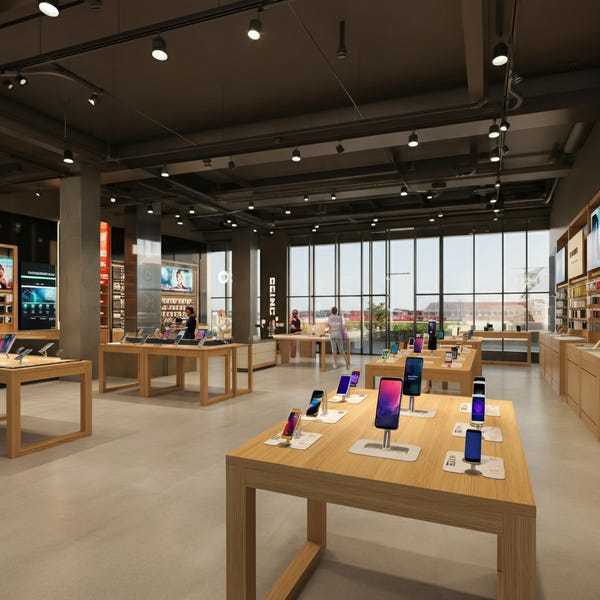How Apple Stores Shape the Way We Shop
How Apple Turns Retail Into a Psychological Masterpiece, Driving Loyalty and Immersive Shopping Experiences
Have you ever walked into an Apple Store intending to browse, only to walk out with a shiny new gadget tucked under your arm? You’re not alone. Apple Stores are more than just retail spaces—they’re immersive theaters where every detail, from the angle of a MacBook screen to the way employees greet you, is meticulously designed to shape how you feel, think, and spend. This is no accident. Apple has mastered the art of retail psychology, turning its stores into powerful touchpoints for customer connection and brand loyalty.
Let’s take a closer look at the subtle yet sophisticated design and psychological tactics that make Apple Stores stand out and why they’ve become benchmarks in the world of retail.
Design That Invites and Inspires
Walk into an Apple Store, and you’ll notice it doesn’t feel like a typical retail store. There’s no clutter of shelves or racks packed with boxes. Instead, the space breathes. It’s open, minimalist, and calming, almost like walking into a high-end art gallery. Why? This intentional spaciousness encourages customers to linger—a strategy borrowed from behavioral economics. The longer you stay, the more likely you are to engage with products, lowering the barrier to making a purchase.
The laptops on display aren’t just laid out randomly; they’re angled at precisely 76 degrees. This seemingly tiny detail is a stroke of genius. It’s not just about presentation—it’s an invitation. To view the screen properly, you have to physically adjust it, prompting touch. This triggers what psychologists call the “endowment effect,” where physically interacting with an object creates a sense of ownership, making you more likely to buy it.
Employees Who Are Specialists, Not Sellers
Unlike traditional retail stores, where employees are trained to push products, Apple’s staff members aren’t stereotypical salespeople—they’re “Specialists.” Their primary role? To build relationships. Drawing inspiration from Ritz Carlton’s legendary customer service, Apple trains its employees to focus on the customer’s needs, not the sale. Conversations are centered around solving a problem, educating, or enhancing the visitor’s experience.
And here’s the kicker—they’re trained not to touch the products on display. This may seem minor, but it’s key to Apple’s strategy. By letting customers handle devices themselves, that sense of ownership deepens, further fostering a connection between the individual and the product.
When your device needs a repair or support, you don’t visit “technical support.” You head to the “Genius Bar.” The Genius Bar branding reframes what could be a frustrating experience into something positive, even empowering. The idea is simple but effective—it makes you feel like you’re sitting down with an expert, not seeking help at a service counter.
Payment Without Pressure
Traditional stores have cash registers—and that’s where many shoppers feel their anxiety spike. Apple sidesteps this with its mobile payment system. Employees carry devices that enable you to pay anywhere on the floor, eliminating the need to queue at a register. This innovation does more than just improve efficiency; it makes the transaction less intimidating. By blending checkout into the casual flow of the visit, Apple keeps the experience seamless and positive.
Stores That Are Town Squares
Apple doesn’t just want you to shop—it wants you to gather. Dubbed “Town Squares” by the company, Apple Stores are designed to be hubs of community interaction and creativity. You’ll often find spacious seating areas, free workshops, and stunning glass windows that flood the space with natural light, creating a warm, inviting environment.
This setup isn’t just about aesthetics. It encourages exploration. Without pressure to “buy and get out,” customers are more likely to stop, experiment with multiple products, and build a personal connection to the ecosystem.
Why It Works
Apple’s strategies work because they tap into human psychology at multiple levels. The endowment effect encourages attachment, branding reframes mundane concepts like support into aspirational experiences, and minimalism strips away distractions, allowing people to focus on their interactions with the products. These tactics don’t feel pushy because they aren’t—they’re crafted to make customers feel in control, valued, and confident in their choices.
Apple also understands that a great retail experience isn’t just about the point of purchase. It’s about creating memories that linger. The seamless, thoughtful attention to detail in its stores turns visitors into brand advocates, willing to return again and again.
Setting a Standard for Retail Innovation
Apple’s approach has had a ripple effect on the broader retail industry. Many brands are following suit by focusing on customer experience over raw sales tactics. Starbucks, for example, similarly designed its stores to be “third spaces”—neither home nor office but a place customers want to spend time. Nike’s flagship stores now offer personalized sports consultations and interactive experiences inspired by Apple’s layout and customer-focused design.
By prioritizing loyalty over immediate transactions, Apple’s strategy helps the brand transcend its products. Customers associate Apple not just with high-quality gadgets but with exceptional experiences. That’s the ultimate win for any company.
Your Turn
Have you had a memorable experience at an Apple Store—or any other retail space that left an impression? Do you think the “Town Square” approach will become the norm for retail? I’d love to hear your thoughts! Drop a comment below and share your perspective. Don’t forget to subscribe for more insights into the fascinating world of innovation, customer experience, and business strategy.



